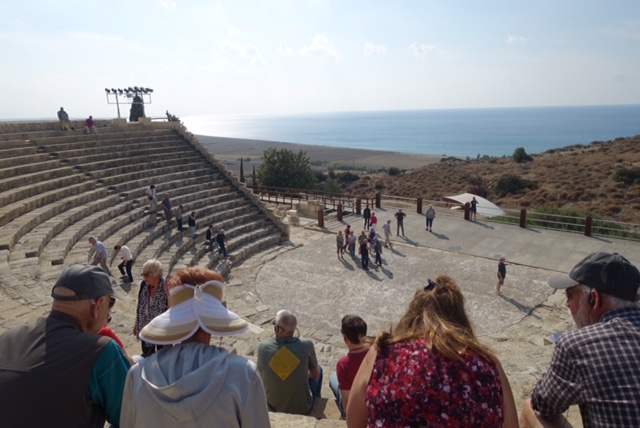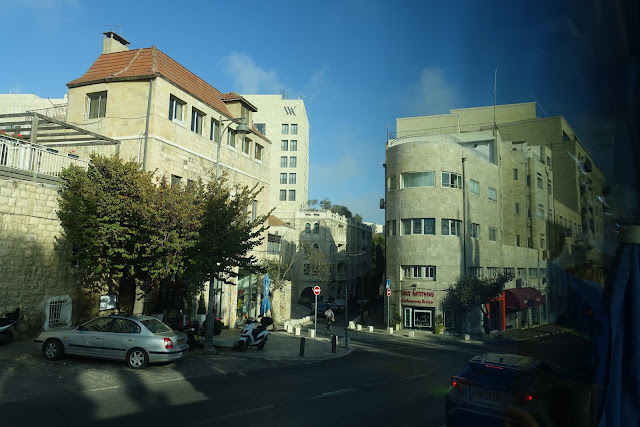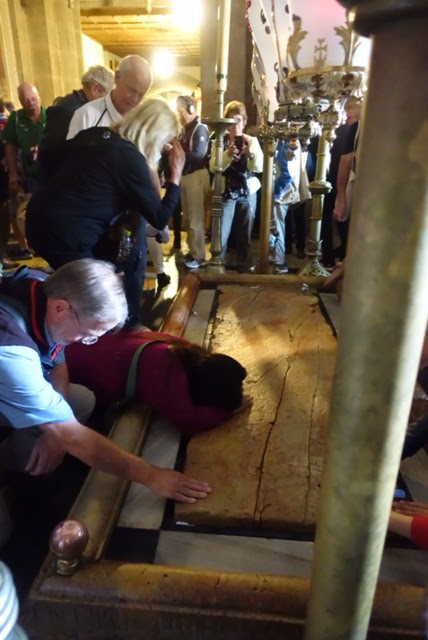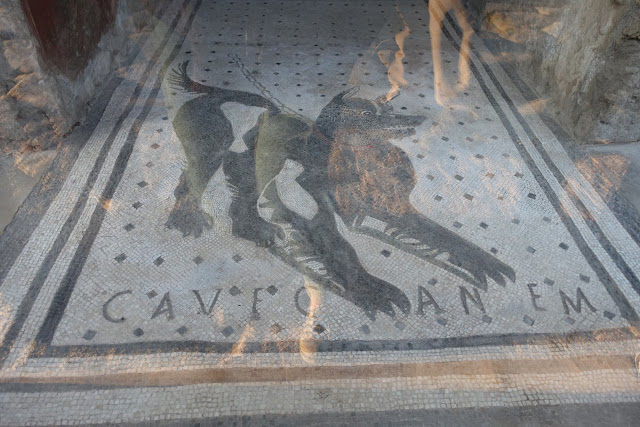
Day One: Sunday, November 4. We arrived in Athens and boarded our ship about 4:00pm Sunday and have been very busy learning and exploring. This map shows our travel route.
Day Two: Monday, November 5. We started Monday with a bus tour of modern day Athens. We drove by a harbor with its dock dating to the 5th century BC and then throughout the city. It’s a mix of some very old remnants of old temples and a stadium, as well as neoclassical and modern day architecture, and lots of graffiti.
 |
We hiked up the limestone hill with a guide to explore Athens’ Acropolis. The largest building, the Parthenon, dates back more than 2,600 years ago. It’s where Greek philosophers like Plato and Aristotle taught and debated.
I was not aware that there are also other temples on top of the Acropolis, for example to Athena and Zeus.
We had some free time in the Plaka District where we had lunch at one of the many sidewalk cafes.
Monday night we returned to the city for views from a rooftop lounge of the illuminated Parthenon and Temples. It was beautiful. Then we walked to a restaurant for dinner and a performance with live music and Greek dancers. Fun!
Day Three: Tuesday, November 6. On Tuesday we spent the morning with a guide exploring and learning about one of the most significant sites in Greek mythology and history. We took a small boat to the island of Delos. It’s only 4 miles long and 1 mile wide and the whole thing is only an archeological site. The only inhabitants are the archeologists. It was fascinating.
In the afternoon we did a ‘Tastes of Mykonos’ walking tour. Mykonos is the smallest of the inhabited Greek islands. It was a favorite of Jackie Onassis and is still known as a party town of the rich and famous. Very quiet and charming this time of year.
One of our stops was at this bakery for a freshly baked koulouri, or sesame bun. Mmmm. We also went to a private organic farm and vineyard for wine tasting and an afternoon snack of bread, cheese and herbed tomatoes, cucumbers and olives.
Day Four: Wednesday, November 7. Wednesday morning we visited The Old Town of Rhodes. Its historic quarter is Europe’s largest active fortified medieval town. We toured the enormous Palace of the Grand Masters, built in the 14th century with the fortunes of knights returning from the Holy Land.
In the afternoon we drove along the coast to Lindos where we hiked up to another acropolis to explore the ruins of the Castle of the Knights. Beautiful views up there.
This is one of the set of stairs we had to climb. That’s Paul down at the bottom.
 |
After coming down from the summit, we walked through the labyrinth of Lindos’s narrow streets to meet back up with our group.
Day Five - Thursday, November 8 [AT SEA]. We enjoyed a day of leisure and lectures.
Day Six - Friday, November 9. After a day at sea we arrived in Cyprus. Today was another day of exploring ... you guessed it - more ruins! There sure are a lot of ‘em in these parts of the world. This photo shows part of a temple complex in the ancient city of Kourion. It was built in the late 4th to early 3rd century BC as a temple to the Greek god, Apollo. It was destroyed by an earthquake in the 4th century AD and abandoned.
Another ancient site we visited was a 34-room private complex from the first century AD. It eventually became a site which included public Roman baths, below where I’m standing. The site is now being carefully preserved with walkways for the public to view the various areas without walking directly through it.
There is also a huge theater on this site. The original structure was large enough to accommodate 10,000 people, but when it was restored, it was reduced to hold 3,500 people. It’s still used for plays and musical performances.
Beautiful mosaics on several floors are also protected from the sun and weather with specially built roofs.
Our last stop of the day was at a fruit plantation where grapes, bananas, and orange and lemon trees grow.
Day Seven - Saturday, November 10. We docked in Haifa, Israel this morning. After Israel’s mandatory immigration inspection, we had a very long day on an optional tour. We drove along the coast to the ancient city of Caesarea. These photos show just a few spots of this huge archaeological site that is still being excavated. It was a magnificent city of homes, shops, a palace, public baths, a theater, a huge coliseum where chariot races, etc. took place. It was built from scratch around 20 BC by King Herod. (He was an egomaniac who had no problem killing anyone who stood in the way of his vision, including a wife and children.)
Day Eight - Sunday, November 11. We disembarked the ship to spend a full two days onshore with an overnight in Jerusalem, visiting some of the most important places in the life of Jesus. In Nazareth, the city of Jesus’s youth, we visited the Church of the Annunciation. This church was built on top of the original church from the 3rd century (part of which can be seen in this photo) which was built on the site where the angel Gabriel announced the coming of Christ.
We also visited the beautiful Church of St. Joseph. This photo shows the excavated portion where Joseph originally had his workshop.
We enjoyed a scenic drive to the Sea of Galilee, passing the village of Cana, where Jesus is said to have turned water into wine. At the River Jordan we saw the site of Jesus’s baptism at Yardenit. People can still be baptized there, as this group in white was doing.
Then we crossed the Jordan Valley to the Dead Sea. We spent an hour and a half here so we would have time to visit the markets and enjoy a dip. Paul passed on the dip, but I did give it a try. The highly mineralized water and mud are supposed to be ‘rejuvenating’ so some slathered the mud all over themselves. I just wanted to try floating in the water. But I was only able to manage getting in up to my knees. The sea floor was extremely uneven, covered with rocks and minerals, and loaded with holes of slimy mud that you suddenly found yourself sinking one foot into. It was all unnerving and not terribly pleasant.
I can’t guarantee this was one of Jesus’s stops, but we enjoyed drinks overlooking the Dead Sea. Yes, it’s about 420 meters (about 1,200 feet) below sea level, making it Earth’s lowest elevation on land and the deepest ‘hypersaline’ lake in the world.
Day Nine: Monday, November 12. This was a very full day. We started the morning with a drive through modern day Jerusalem ....
...and drove to the Mount of Olives for a panoramic view of the Old City of Jerusalem.
We then visited the Garden of Gethsemane which is the name of a natural grotto next to the “Tomb of Mary” and her Assumption. Jesus often visited the grotto and it was here that he was betrayed by Judas and arrested. It is held by tradition that eight olive trees here were the silent witnesses of Jesus’s prayer, arrest and suffering before his crucifixion. One of the olive trees is known to be over 2,000 years old.
The Church of the Agony is beautiful. It enshrines a section of bedrock where Jesus is said to have prayed before he was arrested.
This is a view of that beautiful church from the roadway above.
This afternoon we experienced the most emotionally moving highlights of our trip. The 73-year old Israeli Jew who guided us through the day spoke eloquently, soulfully and compassionately about the sites we visited and the relevance to Jesus’s life and death. We started the afternoon in Jerusalem and crossed through the wall that separates Israel from the Palestinian Authority-controlled territory in the West Bank, into Bethlehem. This photo shows a wall painting of a dove in a bullet proof vest that was painted by the currently famous and controversial Banksy. The sign next to it says “Welcome to Palestine” and “Welcome to Bethlehem.”
We visited the Church of the Nativity - a very differently ornamented church which was built over the site of Jesus’s birth.
Returning to Jerusalem, we visited The Church of the Holy Sepulchre, which is over the site on Golgotha where Jesus was crucified, laid in a small cave tomb and resurrected. This photo shows the Stone of Unction, on which according to tradition Jesus was laid to prepare his body for burial.
We walked along the Via Dolorosa, or “Way of Sorrows”, the road Jesus walked bearing the cross to his crucifixion at the Church of the Holy Sepulchre. Our guide explained each of the ‘stations of the cross’ along this path where Jesus struggled and was aided. This photo shows the fifth station where Simon of Cyrenea helped Jesus carry the cross.
We ended our day visiting the Western Wall, or Wailing Wall, Judaism’s most holy site. The wall is divided into two sections, men on one side and women on the other, where Jews insert written prayers into the mortar’s nooks.
Day Ten: Tuesday, November 13. We enjoyed a day at sea with lectures, a cooking class and some time to relax after such a busy three days in Israel.
Day Eleven: Wednesday, November 14. We spent the morning in Crete. We drove to Heraklion, its capital, which has a long history of human habitation, dating back to 7,000 BC. We visited the Palace of Knossos, built about 2,000 BC, which was uncovered in 1893 and took 35 years to excavate. We walked throughout the remains of this sprawling palace and surrounding area of other buildings.
This long road, the oldest in Crete, leads to the outdoor theater which once held 400 people.
November turned out to be a very nice time to be visiting Greece- so nice to see flowers outside the coffee shop.
After leaving Knossos, we had a guided walking tour of modern day Heraklion and then time on our own to explore. It’s a mix of beautiful old buildings, more modern residential buildings and high end shops. We walked down this road to the harbor.
This shop is a mix of antiques and decorative home goods. The store a little further down with the green awning is a ‘Starbucks’. (They really are everywhere. There was even a suspiciously very similar one we saw in Palestine named ‘Stars and Bucks’!)
Day Twelve: Thursday, November 15. [AT SEA] One final, relaxing day before the finish line in Italy!
Day Thirteen: Friday, November 16. After a drive through the city of Naples, we strolled to the busy Piazza Del Gesu Nuovo where we enjoyed a guided tour of the quiet, exquisite cloisters of Santa Chiara Monastery. This photo is from the interior courtyard, with a small grove of lemon trees surrounded by beautifully tiled columns and walls.
Even the outdoor hallways and ceilings of the courtyard had gorgeous frescoes.
This inside of this magnificent church was such a surprise .....
.... because it was inside the gray very plain looking building on the left! Expectations were very low, of course, based on the outside. But it took your breath away when you entered. (I’m not sure that guard was happy with me taking a picture that included him. It looks like he’s calling for back-up.)
This photo was taken from the bus. We were stuck in heavy traffic in very busy Naples. LOTS of people on scooters constantly darted in and out around and through traffic, sometimes even on the sidewalk. I was holding my breath at times.
We spent the afternoon touring Pompeii ... quite extraordinary. It was founded in the 6th-7th century BC and became a major city during the first century BC. In 79 AD when Mt. Vesuvius erupted, Pompeii was buried under 20 feet of ash. The city covered about 170 acres and was home at the time to about 11,000 people. It was highly preserved because of lack of air and moisture. Excavations continue to this day. We spent a fascinating several hours with a guide walking through a small portion of the city, walking down the cobblestone roads and into various buildings representing various aspects of city life at that time. This home of a wealthy family was remarkably preserved. The courtyard was replanted to show how it probably looked. Frescoes and mosaics are still amazingly colorful.
This brothel had frescoes on the wall illustrating the different ‘services’ that a client could choose!
A typical landscape that we walked through to get to various parts of the city.
This floor mosaic at the entrance to this house is thought to be the earliest ‘Beware of Dog’ warning! (The reflections are from the glass window that was put there to protect the mosaic.)
During later excavations, it was found that when empty spaces in the ash were filled with liquid plaster, images of human and animal bodies were revealed. This one is displayed in one of the many rooms where jars, vases and other household items are displayed.
Day Fourteen: Saturday, November 17. Our last day was spent in Rome. We had guided tours to choose from, but we decided to do “Rome On Your Own” where they just provided roundtrip transportation to and from Rome and the ship. We were dropped off just outside St. Peter’s Square. We had toured the Vatican on a previous trip so we skipped going again. But it’s always worth another photo!
We visited the National Museum of Rome at the Palazzo Altemps that is right off Piazza Navona. The building was originally built in 1484 and was restored as a museum of classical sculpture in the 1990’s.
We then walked over to the Piazza Navona to meet Paul’s friend and former colleague Mariella, who lives in Rome, for lunch. She made reservations for us in a restaurant on the top floor of the white building below. Our dining room is immediately to the right of the bell tower.
Mariella ordered lunch. Here’s the first course - the crispy fried morsels are made with tiny fish that look like teeny tiny worms, the middle dish is octopus, and the top dish is large whole shrimp. (Neither of us can remember the Italian names of these dishes.) You never know what you’re going to get when Mariella orders (we’ve dined with Mariella before and she likes to order food for the table that will provide a regional and interesting experience. She accomplishes that well.) It was actually all really good! The second course was a Sicilian fish dish with lemon, capers and potatoes.
Needless to say, the views out the window that we sat next to were amazing. It looked down onto the piazza as well as all across the skyline. We stopped for gelato as we walked back to catch the bus back to the ship ... the final excursion of a great trip!
I can’t guarantee this was one of Jesus’s stops, but we enjoyed drinks overlooking the Dead Sea. Yes, it’s about 420 meters (about 1,200 feet) below sea level, making it Earth’s lowest elevation on land and the deepest ‘hypersaline’ lake in the world.
We walked along the Via Dolorosa, or “Way of Sorrows”, the road Jesus walked bearing the cross to his crucifixion at the Church of the Holy Sepulchre. Our guide explained each of the ‘stations of the cross’ along this path where Jesus struggled and was aided. This photo shows the fifth station where Simon of Cyrenea helped Jesus carry the cross.
Day Ten: Tuesday, November 13. We enjoyed a day at sea with lectures, a cooking class and some time to relax after such a busy three days in Israel.
Day Twelve: Thursday, November 15. [AT SEA] One final, relaxing day before the finish line in Italy!
***THE END***
























































